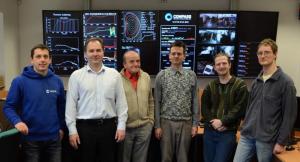Czech COMPASS tokamak masters H-mode
14 Jan 2013
-
Jan Mlynar and Radomir Panek, Institute of Plasma Physics, Prague
The core of the team behind (and in front of) H-mode success: from left to right, Filip Janky (tokamak control systems), Radomír Pánek (head of the Tokamak department), Jan Stöckel (senior physicist), Vladimír Weinzettl (plasma diagnostics), Jozef Varju (neutral beam), and Josef Havlíček (shift operator).
On 29 November 2012, all those who were present in the COMPASS control room cheered when distinctive H‐mode operation was observed for the first time since the tokamak had been reinstalled in the Institute of Plasma Physics in Prague in 2008.
The H‐mode or "high confinement mode" refers to a sudden improvement of plasma confinement in the magnetic field of tokamaks—approximately by a factor of two—and is foreseen as the standard mode of operation for ITER.
The first H‐mode operation in COMPASS was achieved with the 210 kW neutral beam heating: ten milliseconds after the beam injection started, the intensity of visible light known as the Dα radiation suddenly decreased and the plasma stored energy and density considerably increased.
The day after, on 30 November 2012, Ohmic H‐mode operation (i.e., without the beam heating) was achieved during the intentional current ramp‐down phase of the discharge. Transition from Type III ELM (Edge Localized Mode) instabilities to ELM-free H‐mode operation was observed.
In the experiments, the COMPASS plasmas were confined in the divertor configuration, just like the JET and ITER plasma configurations, although five and ten times smaller in linear dimensions, respectively. Mastering H‐mode was very important to the COMPASS team in order to perform similar experiments in support of the large fusion facilities.
In this respect, the COMPASS Tokamak is well equipped with diagnostic systems for studies of the plasma edge, where the so‐called pedestal of the H‐mode is located (the region of plasma edge where pressure increases sharply).
The H‐mode pedestal forms in the region of the plasma transport barrier, which is behind the improved plasma confinement. Better insight into physics of this narrow plasma region is required in order to enhance control of the power flux, plasma heating and the ELM instabilities in fusion reactors.
The H‐mode or "high confinement mode" refers to a sudden improvement of plasma confinement in the magnetic field of tokamaks—approximately by a factor of two—and is foreseen as the standard mode of operation for ITER.
The first H‐mode operation in COMPASS was achieved with the 210 kW neutral beam heating: ten milliseconds after the beam injection started, the intensity of visible light known as the Dα radiation suddenly decreased and the plasma stored energy and density considerably increased.
The day after, on 30 November 2012, Ohmic H‐mode operation (i.e., without the beam heating) was achieved during the intentional current ramp‐down phase of the discharge. Transition from Type III ELM (Edge Localized Mode) instabilities to ELM-free H‐mode operation was observed.
In the experiments, the COMPASS plasmas were confined in the divertor configuration, just like the JET and ITER plasma configurations, although five and ten times smaller in linear dimensions, respectively. Mastering H‐mode was very important to the COMPASS team in order to perform similar experiments in support of the large fusion facilities.
In this respect, the COMPASS Tokamak is well equipped with diagnostic systems for studies of the plasma edge, where the so‐called pedestal of the H‐mode is located (the region of plasma edge where pressure increases sharply).
The H‐mode pedestal forms in the region of the plasma transport barrier, which is behind the improved plasma confinement. Better insight into physics of this narrow plasma region is required in order to enhance control of the power flux, plasma heating and the ELM instabilities in fusion reactors.


